
Pablo Picasso, The Old Guitarist, 1903-04 oil on panel, 122.9 x 82.6 cm (Art Institute of Chicago)
In his painting The Old Guitarist, Picasso made a series of choices to evoke feelings of pity. The guitarist is an old man, with gray hair. The fact that he is seated on the ground suggests that he is playing on the street for spare change. His emaciated state, torn clothes, and dejected posture show poverty and depression.
Furthermore, Picasso does not simply paint the old guitarist exactly as he would appear in real life; he deliberately distorts or exaggerates certain aspects of the scene in order to further intensify his intended expression. Most obviously, the entire work—except for the guitar—is in blue monochrome. This is clearly unrealistic, but it capitalizes on the melancholy emotional quality associated with that color.
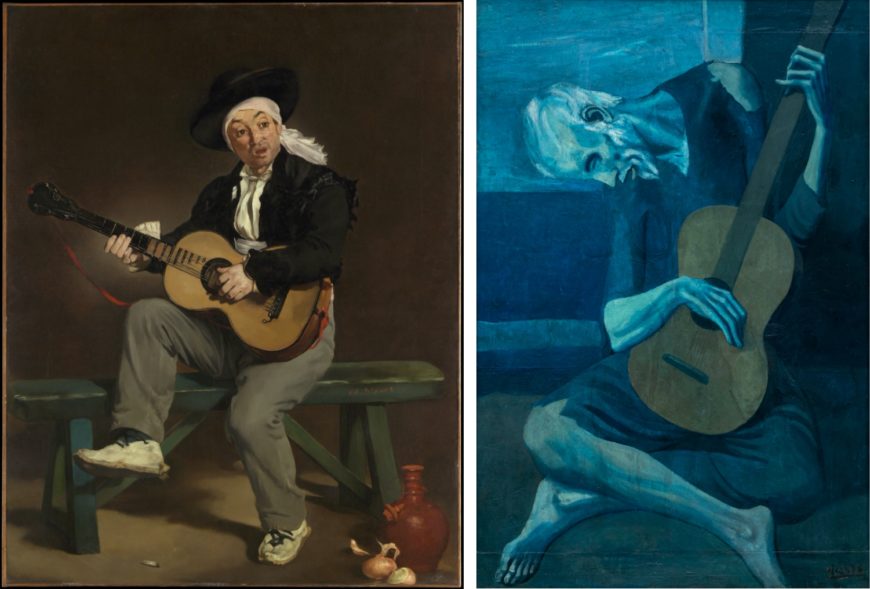
Left: Edouard Manet, The Spanish Singer, 1860, oil on canvas, 58 x 45 cm (The Metropolitan Museum of Art); right: Pablo Picasso, The Old Guitarist, 1903-04 oil on panel, 122.9 x 82.6 cm (Art Institute of Chicago)
When we compare Picasso’s painting to one of a very similar subject by Edouard Manet, we can see other strategic formal distortions. Picasso’s guitarist is in an improbable (if not impossible) pose that is cramped on all sides by the frame. He looks caged or trapped, where Manet’s guitarist, already in a more dynamic pose with his energy thrusting upward, has room to move within the frame. Also, where the form of Manet’s guitarist flows through organic, rounded curves, Picasso has exaggerated the hard angularity of his guitarist, who appears to be all jutting elbows, ankles, and tendons.
These two works exemplify the difference between naturalism and expression as artistic goals. One of Manet’s primary goals was an accurate depiction of the appearance of the guitarist, what art historians call naturalism. As to how to feel about him, we are left largely on our own: it is equally probable that a viewer could pity his evident poverty (examine his worn shoes, five o’clock shadow, and simple meal), or admire his bohemian freedom. Picasso, by contrast, paints his guitarist in an expressive manner, explicitly directing our feelings through his stylistic choices.
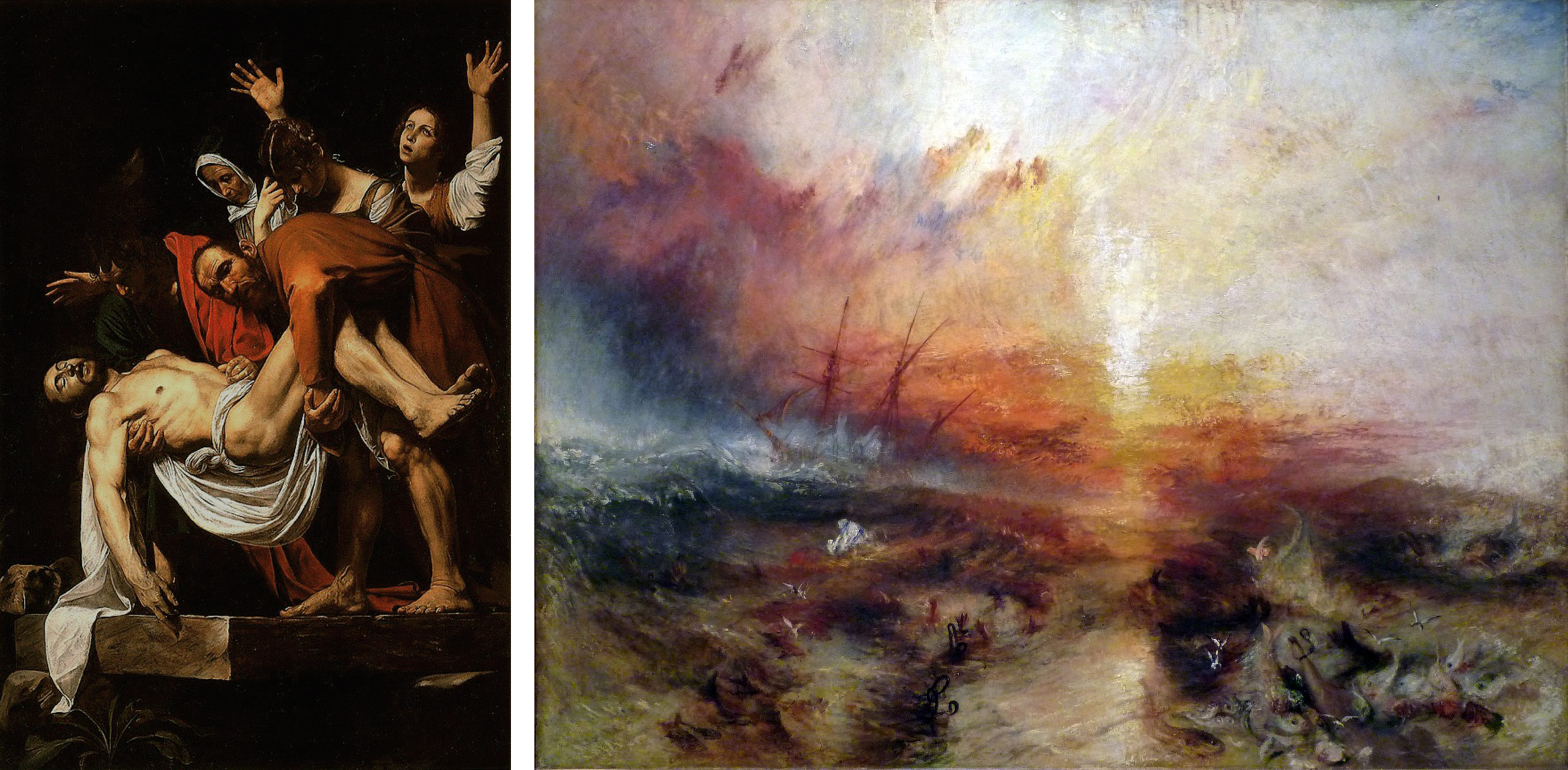
Left: Caravaggio, Deposition (or Entombment), c. 1600-04, oil on canvas, 300 x 203 cm (Vatican Museums); right: J. M. W. Turner, The Slave Ship, 1840, oil on canvas, 90.8 x 122.6 cm (Museum of Fine Arts, Boston)
Picasso’s willingness to sacrifice naturalism in order to enhance the emotional impact of The Old Guitarist is what makes the painting exemplary of modern expression. Between the Renaissance and the nineteenth century (with some notable exceptions, such as El Greco), artists would primarily evoke emotions in ways consistent with naturalism.
In his Deposition, the Baroque artist Caravaggio uses spotlighting, gritty earth colors, and body language to help express the emotional drama of the moment Christ’s body is laid in the tomb, but nothing is too distorted. The work remains naturalistic; you could see such a scene in real life. Romantic artist J. M. W. Turner pushes the boundaries more in his Slave Ship, with obviously painterly brushwork and very intense color, but the painting still looks plausibly like a storm at sea, with the whipping spray and blowing clouds backlit by the setting sun. The Baroque and Romantic periods both emphasized expression as an artistic goal, but both also largely stayed within the confines of naturalistic representation.
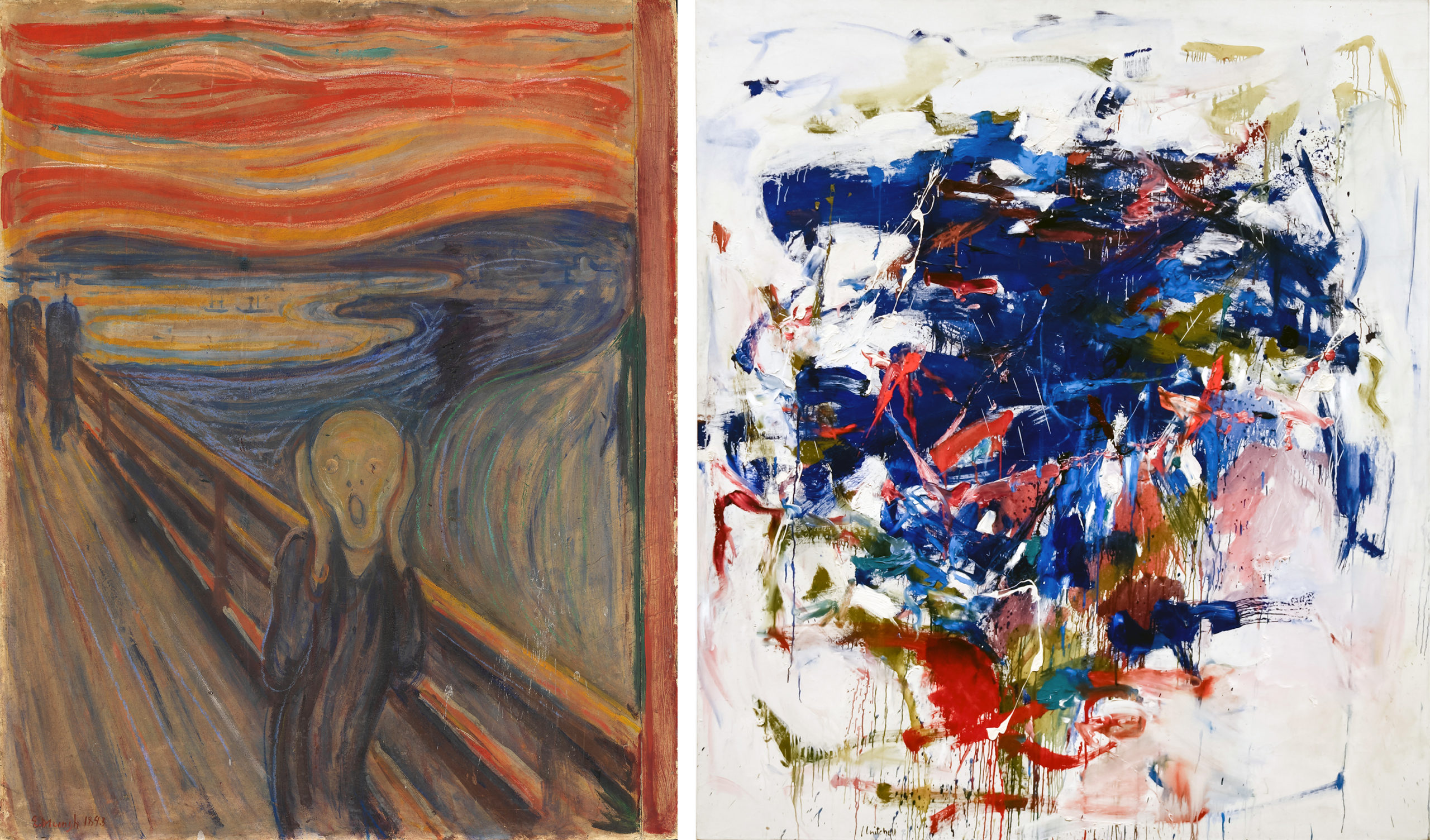
Left: Edvard Munch, The Scream, 1910, tempera on board, 66 x 83 cm (The Munch Museum, Oslo); right: Joan Mitchell, Rock Bottom, 1960-61, oil on canvas, 198.1 x 172.7 cm (Blanton Museum, Austin, Texas)
Starting in the later nineteenth century, the expressionist art movements of the Modern period were increasingly willing to sacrifice naturalism in pursuit of more powerful expressive effects. Although Edvard Munch’s The Scream does include expressive body language in the foreground figure, the painting’s emotional charge is largely carried by its formal distortions. We react first of all to the expressive power of the work’s acrid color, vertiginous recession, and nauseatingly undulating composition, which have been exaggerated to the point where the depicted scene is no longer plausible. Expression has superseded naturalism as the main aesthetic goal. The Modern period saw an increasing recognition of the expressive power of form — color, line, shape, composition, and so on. It is no great conceptual leap from Munch to Joan Mitchell, for whom pure form conveys pure expression, as the name of the Abstract Expressionist movement suggests.
Ex-pression as non-rational
The prefix “ex” means “out,” so to ex-press literally means to push out, reconfirming the distinction between expression and representation or naturalism. In the latter, the motive for the work is out in the world, part of nature, and the artist just re-presents it. With ex-pression, the motive for the work is inside the artist, a mental or emotional state, and must be pushed out.
Expression in art history is generally associated with non-rational states of mind. It is not used to describe works that convey objective facts or for ideas arrived at through rational thought processes. In addition to emotions, the term expression is also used for works that convey spiritual content, such as Vasily Kandinsky’s apocalyptic paintings of the 1910s, and subconscious content, such as the Surrealist André Masson’s automatic drawings of the 1920s.
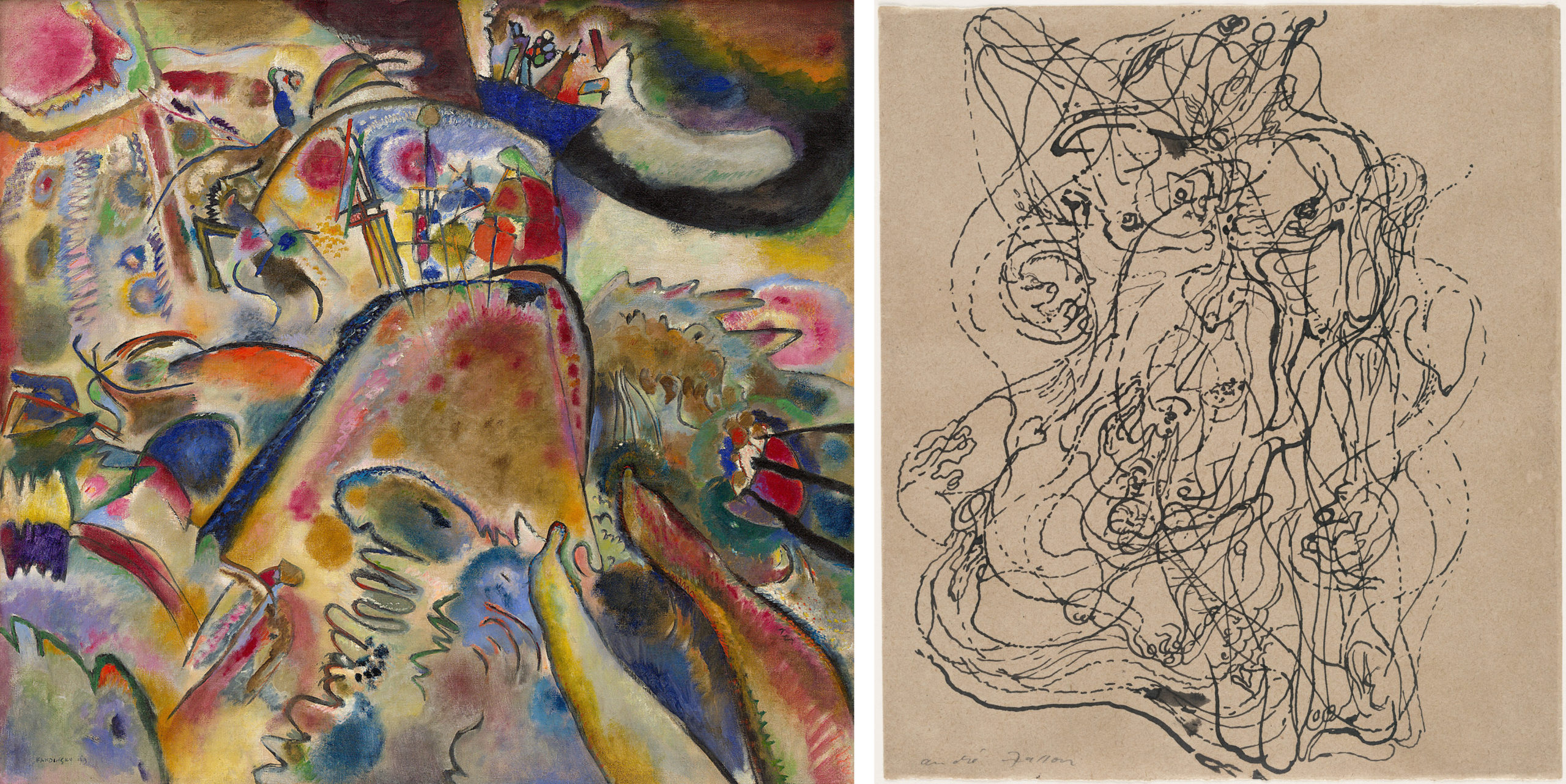
Left: Vasily Kandinsky, Small Pleasures, 1913, oil on canvas, 110.2 x 119.4 cm (Solomon R. Guggenheim Museum, New York); right: André Masson, Automatic Drawing, 1924, ink on paper, 23.5 x 20.6 cm (MoMA)
Because it pertains to non-rational states of mind, expression is often associated with spontaneous or even involuntary creative processes, both mental and manual. While naturalistic art is generally acknowledged to require intensive training, the skills associated with expressionist art are often said to be innate. Correspondingly, rapid or unrefined execution is frequently taken as a sign of expressive intensity, as though the artist’s hand were responding in automatic synchronization with the outpourings of the emotions or unconscious. This is not a universal stylistic characteristic of modern expressionist art, but it is common, as the examples above of Turner, Munch, Mitchell, Masson, and Kandinsky all demonstrate.
The stereotype of the expressionist artist
There is a stereotype of the expressionist artist that — not coincidentally — matches the qualities associated with expressionist art: almost pathologically irrational, careless of social conventions, and spontaneous to the point of being out of control. It seems that in order to express intensely, the artist has to live intensely. Many analyses of The Old Guitarist begin with the story of Picasso’s own adversities at the time, when he was living in poverty in Paris and had just lost a close friend to suicide. Similar stories of the Post-Impressionist Vincent van Gogh’s madness, the German Expressionist Ernst Ludwig Kirchner’s wartime trauma, and the American Neo-Expressionist Jean-Michel Basquiat’s life on the streets are often used to validate the expressive authenticity of their art.
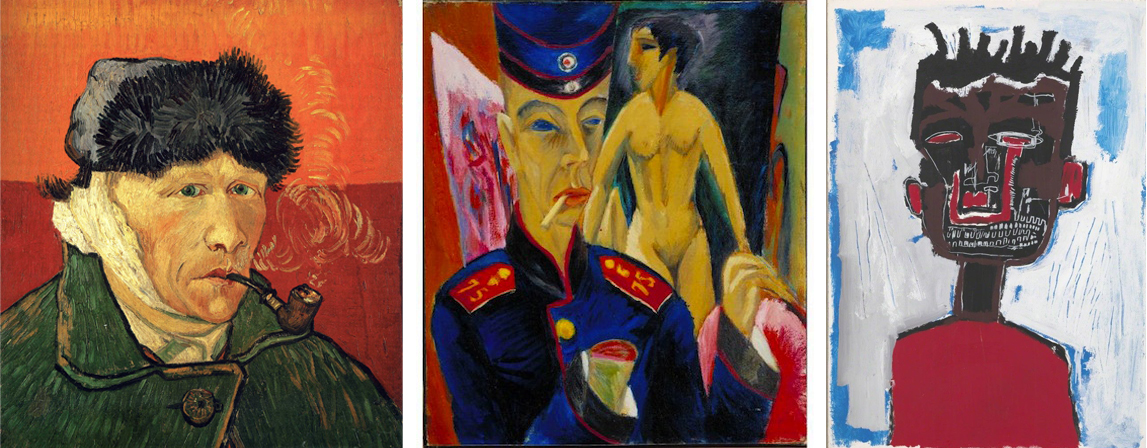
Left: Vincent van Gogh, Self-Portrait with Bandaged Ear and Pipe, 1889, oil on canvas (The Courtauld Gallery, London); center: Ernst Ludwig Kirchner, Self-Portrait as a Soldier, 1915, oil on canvas, 69 x 61 cm (Allen Memorial Art Museum); right: Jean-Michel Basquiat, Self-Portrait, 1984, acrylic and lipstick on paper, 98.7 x 71.1 cm (Gagosian)
We need to maintain a distinction between expression and self-expression, however. The term self-expression is reserved for works whose primary intent is to communicate something about the artist him- or herself. Most modern expressionist art had a broader goal than this. Even when modern artists drew from their own experiences, the intent was to create works that express something about the society or culture of their time, or about the wider human condition. Truly self-expressive works are of limited relevance to outside viewers; this is why art historians typically try to relate works to issues beyond the personal biography of the artists who created them.
Not all modern art is about expression
The concept of expression and the stereotype of the expressionist artist are probably the most commonly evoked justifications for modern art in the popular understanding. If the work does not look like reality, many people assume that it is because the artist was trying to express something, rather than depict something. However, expression of non-rational mental states is only one potential goal of art, and although it was a particularly prominent goal during the modern period, it is not the only motive for non-naturalistic art. We explore other broad answers to the question, ‘Why doesn’t modern art look like reality?’ in the essays The ambiguity of “realism”, Formalism I, and Formalism II.

